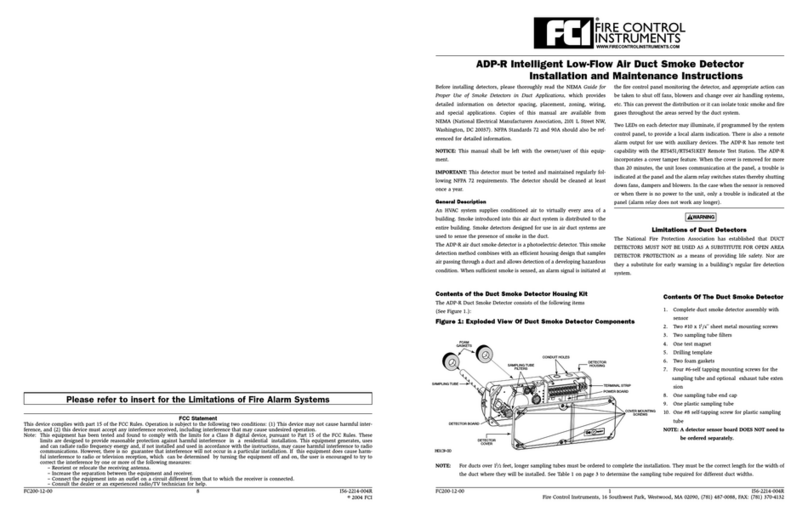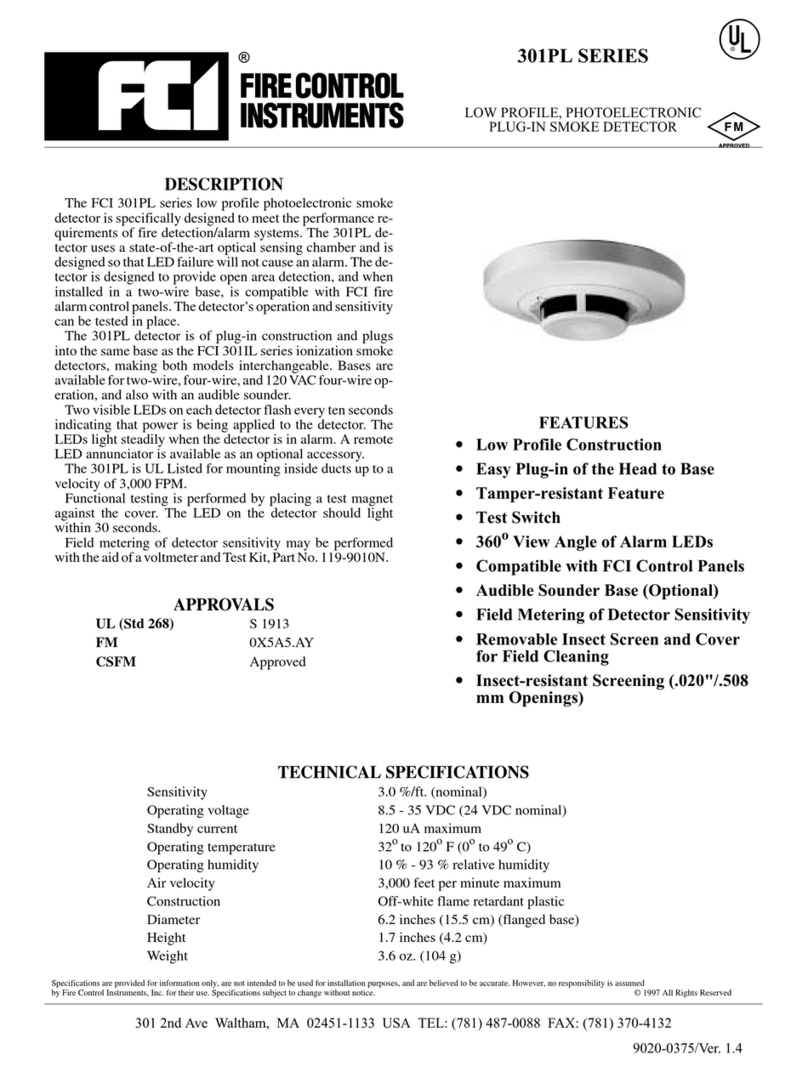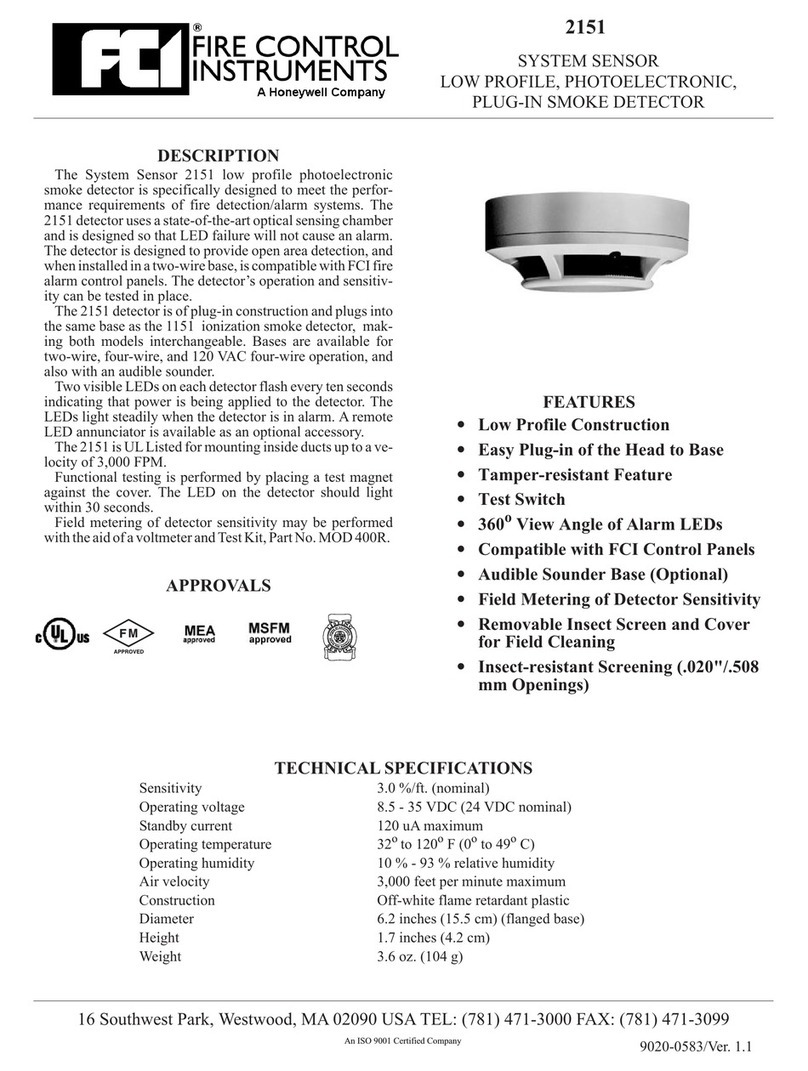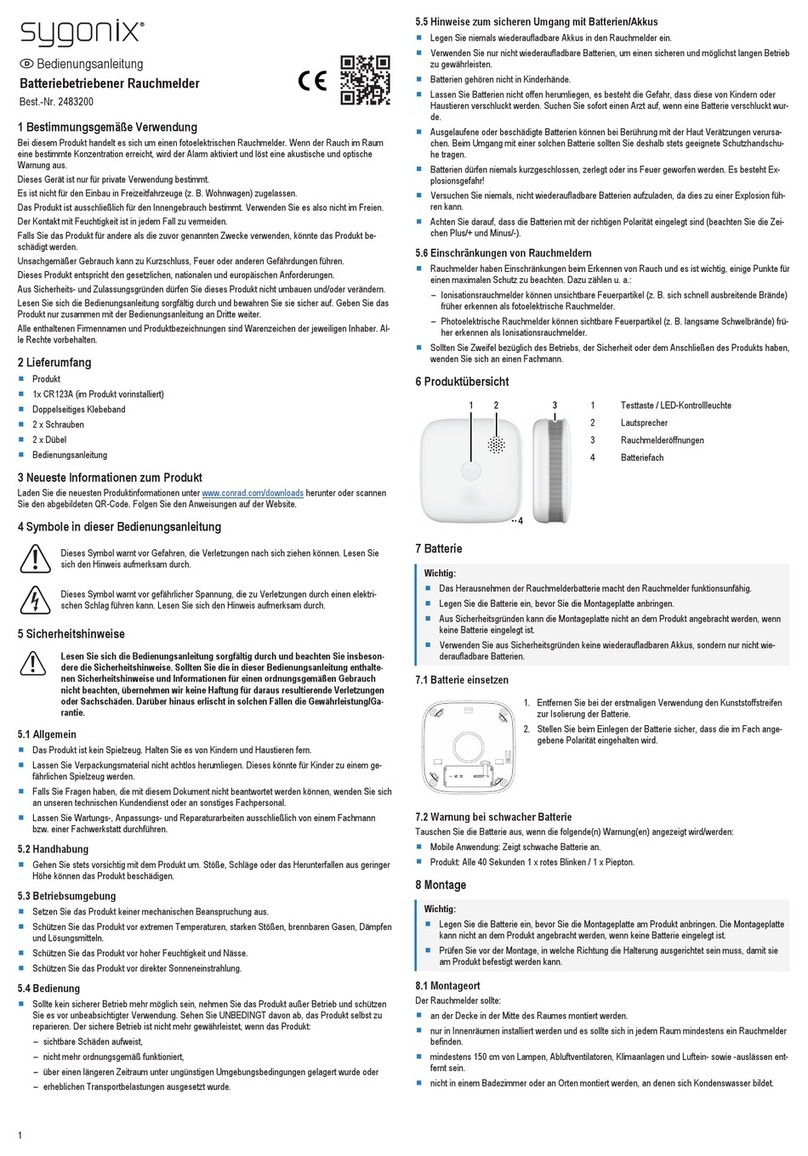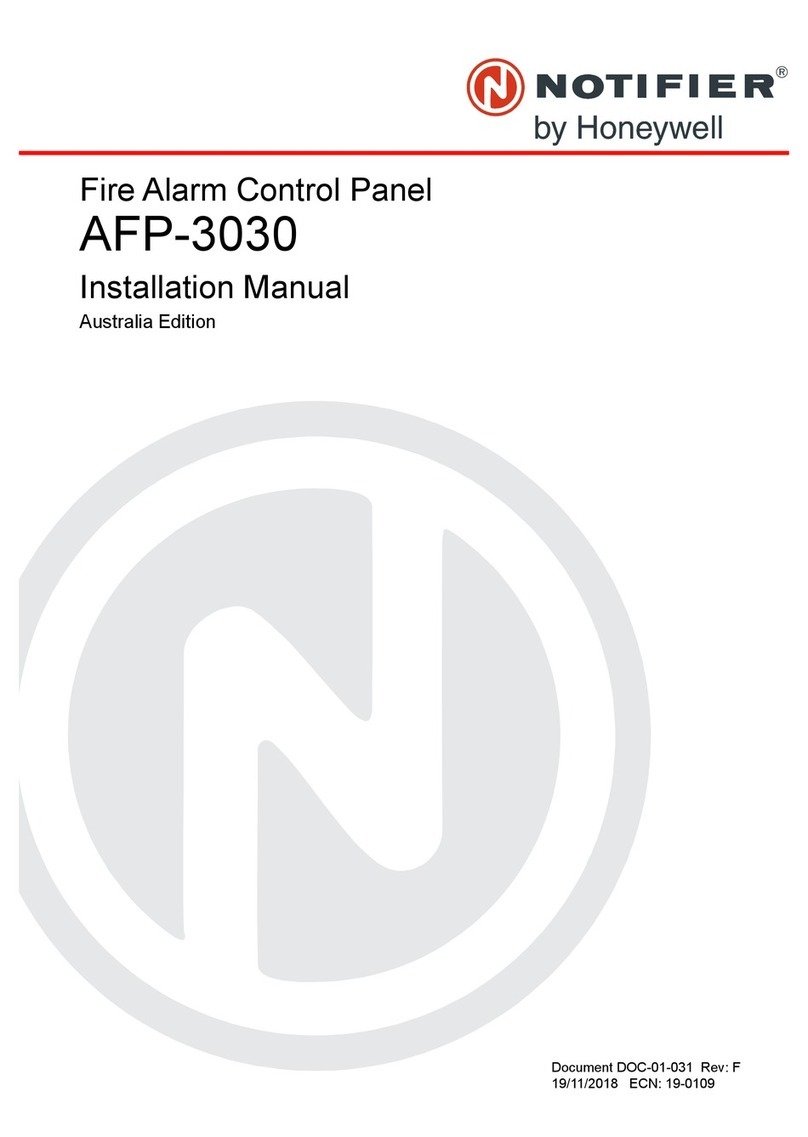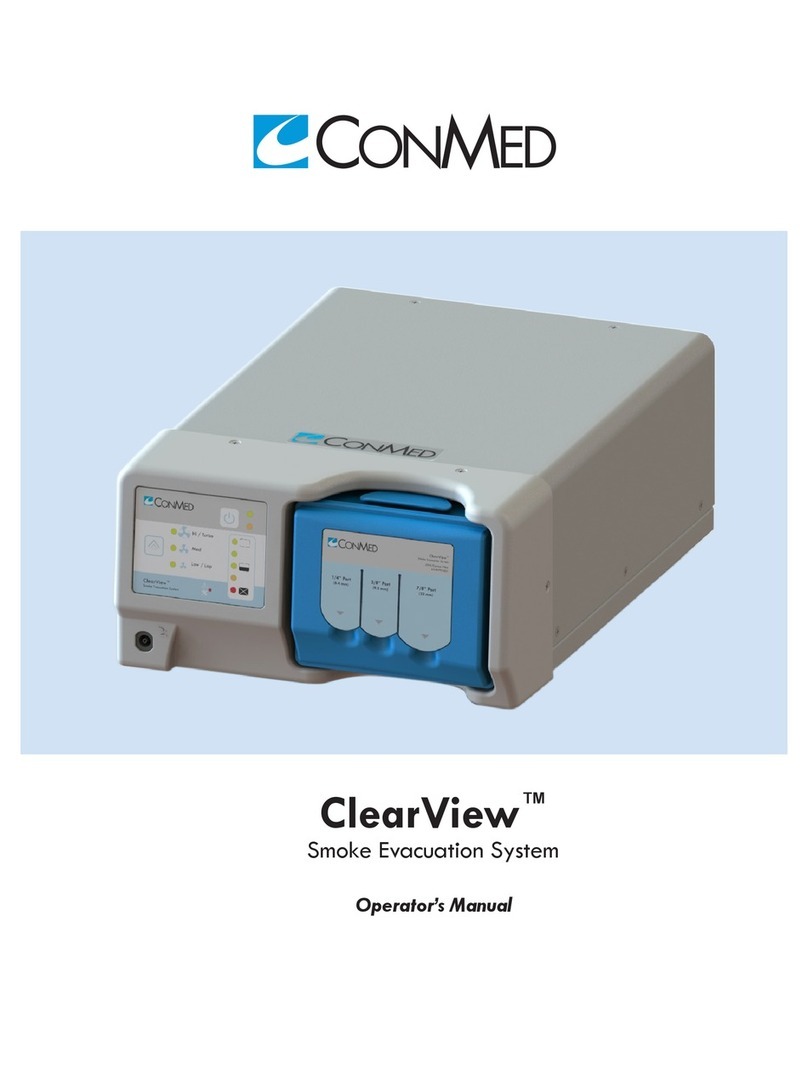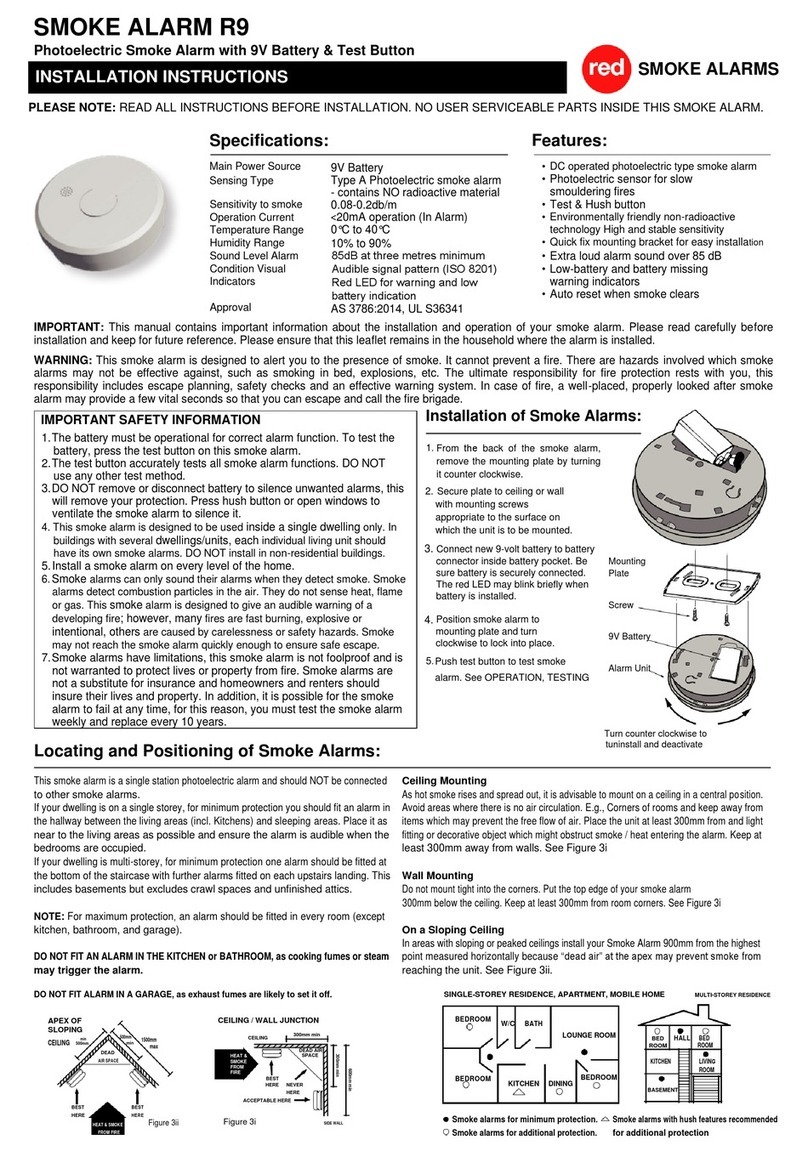FCI 7100 SERIES Installation instructions

301 2nd Ave. Waltham, MA 02451-1133 USA TEL:(781) 487-0088 FAX: (781) 370-4132
Copyright © 1998 Part Number:9000-0447
All Rights Reserved Version 1.4
Published in U.S.A.
7100 SERIES
FIRE ALARM CONTROL
INSTALLATION/OPERATING MANUAL
Technical Manuals Online! - http://www.tech-man.com

Technical Manuals Online! - http://www.tech-man.com

IMPORTANT INFORMATION
This manual is designed for use by factory trained installers and operators of the Fire Control Instruments, Inc.
(FCI) 7100 Series Fire Alarm Control. All illustrations, functional descriptions, operating and installation proce-
dures, and other relevant information are contained in this manual.
The contents of this manual are important, and the manual must be kept with the fire alarm control panel at all
times.If building ownership is changed, this manual, including any testing and maintenance information, must
be passed along to the new owner(s).
The fire alarm control panel is part of a system.Manuals and instructions for other devices forming part of the
system should be kept together. Purchasers who install this system for use by others must leave the instructions
with the user. A copy of these instructions is included with each product and is available from the manufacturer.
This equipment is Listed by various listing agencies for use in fire alarm systems.Use only components which
are compatible with the FCI system.The installation MUST be in accordance with the instructions in this manual.
THEREFORE:
•DO NOT deviate from the procedures described in this manual.
•DO NOT assume any details not shown in the instructions.
•DO NOT modify any electrical or mechanical features.
•DO comply with all codes and standards set forth by the authority having jurisdiction.
The term “Authority Having Jurisdiction” has become a standard term in the fire alarm industry.An acceptable
definition of “Authority Having Jurisdiction” is:
Fire alarm systems installed in the USA fall under the jurisdiction of some authority.In some areas this may be
a local fire department;in other areas it may be a building inspector, insurance firm, etc. Different authorities
may have their own local requirements for the way the fire alarm system is installed and used.Most local
authorities base their requirements on the NFPA codes, but there may be important differences.You must install
this system in the way in which the authority having jurisdiction requires.If you do not know which authority has
jurisdiction in your area, contact your local fire department or building inspector for guidance.
It is important that you tell users to be aware of any requirements defined by the authority having jurisdiction.
The installation MUST be in accordance with the following standards:
•National Fire Alarm Code (NFPA 72)
•National Electrical Code (NFPA 70)
•Life Safety Code (NFPA 101)
WARNING:Touching components which are improperly installed, applied or operated could be
hazardous and possibly fatal. Short circuits could cause arcing that could result in molten metal injuries.
Therefore, only qualified technicians familiar with electrical hazards should perform checkout procedures. Safety
glasses should be worn, and test equipment used for voltage measurements should be designed for this
purpose and be in good working order.
ENVIRONMENTAL CONSIDERATIONS:
It is important that this equipment be operated within its specifications:
Recommended operating temperature range: 60 to 80oF (15 to 27oC)
Absolute maximum operating temperature range: 32 to 120oF (0 to 49oC)
Operating humidity: not to exceed 85%,
non-condensing at 90oF (32oC)
Operating this equipment within the recommended temperature range will extend the useful life of the system
standby batteries.
!
9000-0447 1 of 43
Technical Manuals Online! - http://www.tech-man.com

INSTALLATION CONSIDERATIONS:
Check that you have all the equipment you need to make the installation.Follow the field wiring diagrams and
installation notes in this manual.
Install the equipment in a clean, dry environment (minimal dust).Avoid installing equipment where vibrations
will occur.
Remove all electronic assemblies prior to drilling, filing, reaming, or punching the enclosure.When possible,
make all cable entries from the sides, being careful to separate the power limited conductors from the non-
power limited conductors.Before making modifications, verify that they will not interfere with battery, transformer
and printed circuit board location.
Do not over-tighten screw terminals.Over-tightening may damage threads, resulting in reduced terminal
contact pressure and difficulty with screw terminal removal.
Disconnect all sources of power before servicing, removing, or inserting any circuit boards. Control unit and
associated equipment may be damaged by removing and/or inserting cards, modules, or interconnecting cables
while the unit is energized.
WIRING CONSIDERATIONS:
This fire alarm control panel contains power-limited circuits.You cannot connect external sources of power
to these circuits without invalidating their approval.
Verify that wire sizes are adequate for all initiating device and notification appliance circuits. Most devices
cannot tolerate more than a 10% drop from the specified device voltage.
The installer must make sure that the wiring and devices installed in the system meet the current National
Electrical Code, NFPA 70, and all applicable state and local building code requirements.
Use the conductor size and type required by local codes.(see NFPA 70, Article 760). Wiring resistance must
not be more than that shown on the field wiring diagrams.
To reduce errors and help in servicing the system, all conductors should be tagged or otherwise coded and
logged at installation to identify circuit assignment and polarity.If the conductors are logged with a code, keep
the log that explains the code with the manual, so that it is available to other people working on the panel.
Like all solid state electronic devices, this system may operate erratically or be damaged when subjected
to lightning induced transients. Although no system is completely immune to lightning transients and interfer-
ence, proper grounding will reduce susceptibility.We do not recommend the use of overhead or outside aerial
wiring due to the increased susceptibility to nearby lightning strikes.Consult with the FCI Technical Support
Department if any problems are anticipated or encountered.
To prevent the spread of fire, use proper patching materials to areas where system wiring passes through
fire-rated walls or floors.
OTHER CONSIDERATIONS:
The equipment was tested according to EC directive 89/336/EEC for Class A equipment and was verified
to the limits and methods of EN 55022.
NOTE: System Reacceptance Test: To ensure proper system operation, this product must be tested in
accordance with NFPA 1996, Chapter 7.Reacceptance testing is required after any modification, repair
or adjustment to system hardware or wiring.
All components, circuits, or system operations known to be affected by a change must be 100% tested.
In addition, to ensure that other operations are not inadvertently affected, at least 10% of initiating devices that
are not directly affected by the change, up to a maximum of 50 devices, must also be tested and proper system
operation verified.
Equipment used in the system may not be technically compatible with the control panel.It is essential to use
only equipment listed for service with this control panel.
CAUTION
To keep your fire alarm system in excellent working order, ongoing
maintenance is required per the manufacturer’s recommendations and UL
and NFPA Standards. At a minimum, the requirements of Chapter 7 of
NFPA 72, The National Fire Alarm Code, shall be followed.A preventive
maintenance agreement should be arranged through the manufacturer’s
local representative. Though smoke detectors are designed for long life,
they may fail at any time.Any smoke detector, fire alarm system or any
component of that system which fails shall be repaired or replaced immedi-
ately.
!
2 of 43 9000-0447
Technical Manuals Online! - http://www.tech-man.com

FCC WARNING:This equipment generates, uses, and can radiate radio frequency energy and, if not installed
and used in accordance with the instruction manual, may cause interference to radio communications.It has
been tested and found to comply with the limits for Class A computing device pursuant to Subpart B of Part 15
of FCC Rules, which is designed to provide reasonable protection against such interference when operated in
a commercial environment. Operation of this equipment in a residential area is likely to cause interference, in
which case the user will be required to correct the interference at his own expense.
If these instructions are not clear, or if additional information or clarification is needed, please consult your
local authorized Fire Control Instruments, Inc. distributor.
Because of design changes and product improvements, the information in this manual is subject to change
without notice.FCI reserves the right to change hardware and/or software design, which may subsequently
affect the contents of this manual.FCI assumes no responsibility for any errors that may appear in this manual.
Neither this manual nor any part of it may be reproduced without the advance written permission of Fire
Control Instruments, Inc.
Limitations of Fire Alarm Systems
Manufacturer recommends that smoke and/or heat detectors be located throughout a protected premise
following the recommendations of the current edition of the National Fire Protection Association Standard 72,
National Fire Alarm Code (NFPA 72), manufacturer’s recommendations, State and local codes, and the
recommendations contained in Guide for the Proper Use of System Smoke Detectors, which is made avail-
able at no charge to all installing dealers.A study by the Federal Emergency Management Agency (an agency
of the United States government) indicated that
smoke detectors may not go into alarm or give early warning in
as many as 35% of all fires.
While fire alarm systems are designed to provide warning against fire, they do not
guarantee warning or protection against fire. Any alarm system is subject to compromise or failure to warn
for a variety of reasons. For example:
•Particles of combustion or “smoke” from a developing fire may not reach the sensing chambers of the smoke
detector because:
–Barriers such as closed or partially closed doors, walls, or chimneys may inhibit flow.
–Smoke particles may become “cold” and stratify, and may not reach the ceiling or upper walls
where detectors are located.
–Smoke particles may be blown away from detectors by air outlets
–Smoke particles may be drawn into air returns before reaching the detector.
In general, smoke detectors on one level of a structure cannot be expected to sense fires developing on
another level.
•The amount of “smoke” present may be insufficient to alarm smoke detectors. Smoke detectors are
designed to alarm at various levels of smoke density.If such density levels are not created by a developing
fire at the location of detectors, the detectors will not go into alarm.
•Smoke detectors, even when working properly, have sensing limitations. Detectors that have photoelectronic
sensing chambers tend to detect smoldering fires earlier than flaming fires, which have little visible smoke.
Detectors that have ionizing-type sensing chambers tend to detect fast flaming fires earlier than smoldering
fires.Because fires develop in different ways and are often unpredictable in their growth, neither type
of detector is necessarily best and a given type of detector may not provide adequate warning of a fire.
•Smoke detectors are subject to unwanted or nuisance alarms.For example, a smoke detector located in or
near a kitchen may go into nuisance alarm during normal operation of kitchen appliances.In addition, dusty
or steamy environments may cause a smoke detector to alarm unnecessarily. If the location of a smoke
detector causes an abundance of unwanted or nuisance alarms, do not disconnect the smoke detector;
call a professional to analyze the situation and recommend a solution.
9000-0447 3 of 43
Technical Manuals Online! - http://www.tech-man.com

•Smoke detectors cannot be expected to provide adequate warning of fires caused by arson, children
playing with matches (especially within bedrooms), smoking in bed, violent explosions (caused by
escaping gas, improper storage of flammable materials, etc.).
•Heat detectors do not sense particles of combustion and are designed to alarm only when heat on their
sensors increase at a predetermined rate or reaches a predetermined level.Heat detectors are designed
to protect property, not life.
•Warning devices (including horns, sirens, and bells) may not alert people or awaken sleepers who are
located on the other side of closed or partially open doors.A warning device that activates on a different
floor or level of a dwelling or structure is less likely to awaken or alert people. Even persons who are awake
may not notice the warning if the alarm is muffled by noise from a stereo, radio, air conditioner or other
appliance, or by passing traffic.Audible warning devices may not alert the hearing-impaired (strobes or
other devices should be provided to warn these people).Any warning device may fail to alert people with
a disability, deep sleepers, people who have recently used alcohol or drugs, or people on medication
or sleeping pills.
Please note that:
I) Strobes can, under certain circumstances, cause seizures in people with conditions such as
epilepsy.
II) Studies have shown that certain people, even when they hear a fire alarm signal, do not respond
or comprehend the meaning of the signal.It is the property owner’s responsibility to conduct fire drills
and other training exercises to make people aware of fire alarm signals and instruct on the proper
reaction to alarm signals.
III) In rare instances, the sounding of a warning device can cause temporary or permanent hearing
loss.
•Telephone lines needed to transmit alarm signals from a premises to a central station may be out of
service or temporarily out of service.For added protection against telephone line failure, backup radio
transmission systems are recommended.
•System components, though designed to last many years, can fail at any time. As a precautionary meas-
ure, it is recommended that smoke detectors be checked, maintained, and replaced per manufacturer’s
recommendations.
•System components will not work without electrical power. If system batteries are not serviced or replaced
regularly, they may not provide battery backup when AC power fails.
•Environments with high air velocity or that are dusty or dirty require more frequent maintenance.
In general, fire alarm systems and devices will not work without power and will not function properly unless
they are maintained and tested regularly.
While installing a fire alarm system may make the owner eligible for a lower insurance rate, an alarm system
is not a substitute for insurance. Property owners should continue to act prudently in protecting the premises
and the people in the premises and should properly insure life and property and buy sufficient amounts of
liability insurance to meet their needs.
4 of 43 9000-0447
Technical Manuals Online! - http://www.tech-man.com

9000-0447 5 of 43
Technical Manuals Online! - http://www.tech-man.com

TABLE OF CONTENTS
Page
IMPORTANT INFORMATION..........................................................................................................1
1.0 System Overview......................................................................................................................9
1.1 Description...............................................................................................................................9
1.2 Features ..................................................................................................................................9
1.2.1 Standard Features .............................................................................................................9
1.2.2 Optional Features ..............................................................................................................9
1.3 Control and Indicators..............................................................................................................10
1.3.1 Switch Controls..................................................................................................................10
1.3.2 LED Indicators....................................................................................................................10
1.3.3 Audible Sounder.................................................................................................................10
1.4 Optional Modules.....................................................................................................................10
1.4.1 Digital Alarm Communicator Transmitter (DACT)...............................................................10
1.4.2 Class A Option Module (CAOM) ........................................................................................10
1.4.3 Municipal Circuit Option Module (MCOM)..........................................................................10
1.4.4 Printer Transient Module (PTRM).......................................................................................11
1.5 Specifications...........................................................................................................................11
2.0 Installation.................................................................................................................................13
2.1 General ..................................................................................................................................13
3.0 Basic System Module (BSM) ....................................................................................................13
3.1 Power ..................................................................................................................................14
3.1.1 AC Input ...........................................................................................................................14
3.1.2 Battery Connections...........................................................................................................14
3.1.3 Auxiliary Power Output.......................................................................................................14
3.1.4 Earth Ground .....................................................................................................................14
3.2 Relay Connections...................................................................................................................14
3.3 Notification Appliance Circuits.................................................................................................16
3.4 Signaling Line Circuits.............................................................................................................16
3.5 Analog Sensors .......................................................................................................................18
3.5.1 Address Switches ..............................................................................................................18
3.5.1 Drift compensation.............................................................................................................18
3.6 Addressable Modules..............................................................................................................18
3.6.1 Address Switches ..............................................................................................................18
3.7 Monitor Modules .....................................................................................................................18
3.8 Control Modules.......................................................................................................................18
3.9 Optional Modules.....................................................................................................................18
3.9.1 Class A Option Module (CAOM) ........................................................................................18
3.9.2 Municipal Circuit Option Module (MCOM)..........................................................................18
3.9.3 Printer Transient Module (PTRM).......................................................................................21
3.10 Digital Communicator Operation (Model 7100-D)..................................................................21
3.11 Central Station Reporting......................................................................................................21
3.12 7100-D DACT Event Reporting Codes..................................................................................22
3.13 Telephone Requirements ......................................................................................................22
3.14 Digital Communicator ............................................................................................................23
3.15 Telephone Company Rights and Warnings............................................................................23
3.16 FCC Required Information.....................................................................................................23
3.17 Repairs ..................................................................................................................................23
3.18 Optional Accessories.............................................................................................................23
3.18.1 LCD-7100 Remote Serial Annunciator.............................................................................23
6 of 43 9000-0447
Technical Manuals Online! - http://www.tech-man.com

TABLE OF CONTENTS
Continued
4.0 Programming/Operating............................................................................................................23
4.1 LED Indicators.........................................................................................................................23
4.2 Panel Switches ........................................................................................................................24
5.0 System Programming ...............................................................................................................25
5.1 Main Menu Selections .............................................................................................................25
5.1.1 Addresses..........................................................................................................................25
5.2 Config. Menu Selections..........................................................................................................27
5.3 WALK/DRILL Menu Selections................................................................................................34
5.4 I/O Menu Selections ................................................................................................................34
5.5 CLOCK Menu Selections.........................................................................................................36
5.6 LOG Menu Selections..............................................................................................................38
5.7 INFO Menu Selections.............................................................................................................38
6.0 Power Up Procedure.................................................................................................................40
6.1 General ..................................................................................................................................40
6.2 To set the system time .............................................................................................................40
6.3 Automatic Configuration ..........................................................................................................40
Appendix
7100 Series Device Types and Functions......................................................................................41
Typical 7100/DRBC-1 Hookup.......................................................................................................42
Power Limited/non-power limited Wiring Connections...................................................................43
9000-0447 7 of 43
Technical Manuals Online! - http://www.tech-man.com

JMP1
BSM
TB2 TB3 TB4
TB6 TB9
TB1
TB7
TB5
8 of 43 9000-0447
Technical Manuals Online! - http://www.tech-man.com

1.0 System Overview
1.1 Description
The FCI 7100 is a multiprocessor-based analog/addressable fire alarm control panel, designed for commer-
cial, industrial and institutional fire alarm applications.It is available with one or two signaling line circuits.
The 7100 Series Fire Alarm Control is Listed by Underwriters Laboratories Standard UL 864. It is suitable for
the following signaling services:
•Automatic Fire Detector alarm
•Manual Fire Alarm
•Waterflow Alarm
•Supervisory
•Automatic smoke alarm, non-coded and master coded operation
•Releasing Device service
The 7100 Series complies with the requirements of the following National Fire Protection Association (NFPA)
Standards:
•NFPA 13 - Installation of Sprinkler Systems
•NFPA 16 - Deluge Foam-Water Sprinkler Systems
•NFPA 16A - Installation of Closed Head Foam-water Sprinkler Systems
•NFPA 72 - National Fire Alarm Code:
–Central Station Fire Alarm Systems
–Local Fire Alarm Systems
–Auxiliary Fire Alarm Systems
–Remote Station Fire Alarm Systems
–Proprietary Fire Alarm Systems
1.2 Features
1.2.1 Standard Features
•Two (2) Class B, Style 4 Signaling Line Circuits - Model 7100-2/D (One circuit in Model 7100-1/D)
•Two (2) Class B, Style Y Notification Appliance Circuits
•Alarm and Trouble dry contacts
•Accommodates 99 FCI Approved, UL Listed compatible analog sensors per SLC
•Accommodates 98 FCI Approved, UL Listed compatible addressable monitor/control devices per SLC
•80-character alphanumeric LCD display
•500 event history buffer (non-volatile)
•Power limited
•Resettable/Non-resettable 1.0 amp.@ 24 VDC power output
•Alarm verification
•Walk test
•Multi-level alarm processing
•Positive alarm Sequence (PAS) operation
•NAC coding
•Trouble reminder
•Integral RS-232 port
•Key Switch - keyed alike with the door lock and renders the key pad inoperative until activated.
1.2.2 Optional Features
•Class A Module (CAOM) with Disconnect Switches for NACs and SLCs
•Digital Alarm Communicator (DACT) (Model 7100-D)
•RS-232 Printer Transient Module (PTRM), Supervised
•Municipal Circuit Option Module (MCOM)
9000-0447 9 of 43
Technical Manuals Online! - http://www.tech-man.com

1.3 Control and Indicators
1.3.1 Switch Controls
•Alarm Acknowledge
•Trouble Acknowledge
•Signal Silence
•System Reset/Lamp test
•Programming buttons
–Menu/Back
–Back Space/Edit
–OK
•12 button keypad
1.3.2 LED Indicators
•AC Power On (green)
•Alarm (red)
•Supervisory (yellow)
•System Trouble (yellow)
•Power Fault (yellow)
1.3.3 Audible Sounder
An Alarm/Trouble sounder is located on the Basic System Module (BSM)
1.4 Optional Modules
The following optional modules and
features are available:
1.4.1 Digital Communicator (DACT)
The Model 7100-D provides an integral digital communicator (DACT), fully programmable from the keypad,
which is compatible with Digital Alarm Receivers (DACRs) that can receive the following formats:
SIA DC8
SIA DCS20
Ademco Contact ID
3+1 1400 Hz
3+1 2300 Hz
4+2 1400 Hz
4+2 2300 Hz
1.4.2 Class A Option Module (CAOM)
All 7100 Models are supplied with Class B Notification Appliance Circuits and Class B Signaling Line Circuits.
For Class A operation, the addition of a CAOM Module is required.This module operates with all 7100 Models
and enables the signaling line circuits to operate as Class A, Style 6 or 7 and notification appliance circuits to
operate as Class A, Style Z.It supplies the additional terminals for these circuits.
1.4.3 Municipal Circuit Option Module (MCOM)
The MCOM Module can trip a Local Energy City Master Box, operate in reverse polarity mode for leased line
connection, or energize a solenoid for releasing service.
•Ground Fault (yellow)
•NAC 1Silenced (yellow)
•NAC 2 Silenced (yellow)
•System Silenced (yellow)
10 of 43 9000-0447
Technical Manuals Online! - http://www.tech-man.com

1.4.4 Printer Transient Module (PTRM)
The serial output on the BSM is via an existing RS-232 RJ-11 connector, J3.This can be used to communi-
cate to the control with a laptop computer while at the panel.The PTRM module is intended for systems where
a permanent connection is required.This type of connection requires that the RS-232 port have sufficient
transient protection to comply with the applicable codes for wiring leaving the confines of the control box, as well
as the proper isolation of the signal to prevent damage or interference caused by connection to certain EDP
devices. Connections are limited to the same room.The PTRM supplies supervision and transient protection as
well as the necessary isolation.
1.5 Specifications
Power Supply
Supervisory current 1.0 amp.(max.) (24 VDC nominal)
Alarm current 3.335 amp.(max.) (24 VDC nominal)
Notification Appliance Circuits (TB1)
Two (2) regulated power outputs
Power limited
Supervised
Non-coded
Max. alarm load 1.5 amp. /circuit
For use with any Listed appliance with operating voltage range 17-26 VDC
Use U.L. Listed End of Line Resistor EOL-N (47K), P/N 4700-0512
Trouble Dry Contacts (TB2)
Form “C”
Rated 2 amp.@ 30 VDC
Alarm Dry Contacts (TB2)
Form “C”
Rated 2 amp.@ 30 VDC
Transfer Relay Control (TB2)
To transmit loss of AC power or brown out to FCI Model DRBC-1 charger.
Power limited
Unsupervised
Signaling Line Circuits (TB3)
One (1) or two (2) Class “B”, Style 4 circuits
24 VDC nominal
Power Limited
Supervised
40 ohm max. line resistance
0.5 uf max. capacitance
Capacity of 99 analog sensors and 98 addressable devices per circuit
Earth Ground Connection (TB4)
AC Input (TB6)
120/240 VAC, 50/60 Hz, 2 amp.@ 120 VAC, 1 amp.@ 240 VAC
Non-power limited
NOTICE: Terminal TB4 must be connected to an earth ground connection per Article 760 of the National
Electric Code.Failure to make a proper earth ground connection to a metallic cold water pipe or driven
ground rod to this terminal will result in loss of lightning protection, reduce the tolerance of the system to
transients, and will adversely affect the operation of the system.Panel neutral or conduit ground is not
acceptable;minimum wire size is 14 AWG.
!
9000-0447 11 of 43
Technical Manuals Online! - http://www.tech-man.com

24 VDC power, system (TB4)
Unregulated
Resettable and non-resettable
1.0 amp. max. each circuit, 1.0 amp. max.combined
Unsupervised
Battery Connection (TB7)
Supervised
24 VDC nominal
Max. battery size 31 AH
Non-power limited
0.6 A max. battery charge current
The RS-232 port, consists of an RJ11 connector which provides a standard serial port for connection to a
Listed output device for supplementary type service.Typical examples of such devices include any UL Listed
EDP device (remote printer or video terminal), any UL Listed Signaling Device (such as the Keltron VS4095/5
printer), or any UL Listed Signal System Unit (such as the Model BBM Buffered Data Broadcast unit TL160A-
R2).
Ratings: 15 VDC (max.)
.05 amp. (max.) current
9600 baud
8 bits, 1 stop bit, no parity.
Connections to the RJ11 serial connector are as follows:
Terminal Description
2 RXD
3, 4 GND
5 TXD
6 Supervision
Available cables for RS-232 connection are:
Part No. Model Description
6100-0077 RJ11-DB9PC RJ11 to 9-pin DB9
(Connector only - PC Laptop)
6100-0074 RJ11-DB25 RJ11 to 25-pin (DB25) (connector only-printer)
6100-0075 RJ11C-6 RJ11 to RJ11 cable, 6-inches
6100-0076 RJ11C-20 RJ11 to RJ11 cable, 20 feet
NOTE: The BSM is shipped with jumpers installed on the middle three pairs of pins on J2. These jumpers must
be removed when the PTRM is installed.
These jumpers must be removed prior to installing the PTRM
module.
BSM J2
1
2
3
4
5
6
RJ11 Connector
12 of 43 9000-0447
Technical Manuals Online! - http://www.tech-man.com

2.0 Installation
2.1 General
The 7100 is shipped unassembled.The shipping carton contains an installation drawing, backbox, Basic
System Module (BSM), power transformer and door.
1) Refer to the System Assembly Drawing, P/N 9000-0457.
2) The BSM module consists of a main operating board with pluggable terminal strips, an 80-character LCD
display and programming keypad. Install this module immediately unless any option modules are to be used in
the system. The optional modules are supplied separately, and should be installed on the BSM before it is
mounted in the backbox.Before installing the BSM into the system backbox, refer to the installation instruction
sheets shipped with each module for the proper installation procedures.
3) Install the transformer into the backbox.
4) Install the door after the BSM is in place. Note that the door can only be installed (or removed) when it is
opened at least 90ofrom the backbox.
3.0 Basic System Module (BSM)
Designation Description Comments
TB1-1 NAC Circuit 1 (+) Class B, Style Y
TB1-2 NAC Circuit 1 ( - ) Class B, Style Y
TB1-3 NAC Circuit 2 (+) Class B, Style Y
TB1-4 NAC Circuit 2 ( - ) Class B, Style Y
TB2-1 TRBL Trouble contacts, N/O, 2 amp @ 30 VDC (resistive)
TB2-2 TRBL Trouble contacts, Common
TB2-3 TRBL Trouble contacts N/C
TB2-4 ALM Alarm contacts, N/O, 2 amp.@ 30 VDC (resistive)
TB2-5 ALM Alarm contacts, Common
TB2-6 ALM Alarm contacts, N/C
TB2-7 Transfer control
TB2-8 Not used
TB3-1 Signaling Line Circuit 1 (+) Class B, Style 4
TB3-2 Signaling Line Circuit 1 ( - ) Class B, Style 4
TB3-3 Signaling Line Circuit 2 (+) Class B, Style 4 (7100-2, -2D only)
TB3-4 Signaling Line Circuit 2 ( - ) Class B, Style 4 (7100-2, -2D only)
TB4-1 Resettable Power, 24 VDC 1.0 amp.
TB4-2 Non-resettable Power, 24 VDC 1.0 amp.
TB4-3 System Common
TB4-4 Earth Ground
TB5-1 COM B To LCD-7100 TB1-2
TB5-2 COM A To LCD-7100 TB1-1
TB5-3, -4 Not used
TB6-1 AC “Hot” 120 VAC “Hot”, 50/60 Hz 2 amp., 240 VAC “Hot”, 50/60 Hz 1 amp.
TB6-2 Ground Ground
TB6-3 AC Neutral 120 VAC Neutral, 240 VAC “Hot”
TB7-1 Batt+ Battery terminal (+)
TB7-2 Batt - Battery terminal ( - )
TB9-1 DACT Line 1 Tip In (non-power limited) From street
TB9-2 DACT Line 1 Ring In (non-power limited) From street
TB9-3 DACT Line 1 Tip Out (non-power limited) To phone
TB9-4 DACT Line 1 Ring Out (non-power limited) To phone
TB9-5 DACT Line 2 Tip In (non-power limited) From street
TB9-6 DACT Line 2 Ring In (non-power limited) From street
TB9-7 DACT Line 2 Tip Out (non-power limited) To phone
TB9-8 DACT Line 2 Ring Out (non-power limited) To phone
Table 1 Field Wiring Connections
9000-0447 13 of 43
Technical Manuals Online! - http://www.tech-man.com

3.1 Power
3.1.1 AC Input
Connection of the 120/240 VAC, 50/60 Hz power source must be made per the requirements of the National
Electrical Code, NFPA 70, Article 760, the applicable NFPA requirements, and/or the Authority Having
Jurisdiction.
Guidelines to follow are:
•Connections must be to a dedicated branch circuit
•Connections must be mechanically protected
•All means of disconnecting the circuit must be clearly marked: “FIRE ALARM CIRCUIT CONTROL.
•Accessible only to authorized personnel.
•For 240 VAC operation, no conductor shall have a potential greater than 150 V to ground.
See Table 1 for AC input and battery connections.
3.1.2 Battery Connections
TB7-1 is positive. See Table 1.
TB7-2 is negative.See Table 1.
Observe polarity
See Table 2 for Battery Calculations
3.1.3 Auxiliary Power Output, Resettable/non-resettable
TB4-1 Resettable, 24 VDC, max.1.0 amp.Suitable for use with projected beam smoke detectors SPB-24,
770 Series, or DH Series duct detectors.
TB4-2 Non-resettable, 24 VDC, max. 1.0 amp.Suitable for use with the FM Series door holders.
NOTE: Total output is 1.0 amp max.combined.
TB4-3 Common negative
TB4-4 Not used
3.1.4 Earth Ground Connection
TB4-4 Earth Ground
3.2 Relay Connections
System Trouble Contacts
TB2-1 Normally Open
TB2-2 Common
TB2-3 Normally Closed
Transfers on any trouble condition and/or supervisory alarm.
System Alarm Contacts
TB2-4 Normally Open
TB2-5 Common
TB2-6 Normally Closed
Transfers upon any system alarm except supervisory.
Designation Description Comments
LEDs
LED25 Yellow Line 1 Trouble
LED26 Yellow Line 2 Trouble
Jumpers
W1 Not used
W2 OUT to disable battery
W3 IN - No Local Phone Line 1
W4 IN - No Local Phone Line 2
J6 Connection to keypad
JMP1 Cut for 240 VAC input operation
Table 1a - LEDs, Jumpers
IMPORTANT: Always apply AC power first, then connect the batteries.
14 of 43 9000-0447
Technical Manuals Online! - http://www.tech-man.com

Total Total
Supv. Alarm Supv. Alarm
Qty Module Description Current Current Current Current
BSM-1 Basic System Module, 1 SLC 0.056 A 0.076 A
BSM-2 Basic System Module, 2 SLC 0.065 A 0.085 A
BSM-1D Basic System Module, 1 SLC
w/DACT 0.075 A 0.095 A
BSM-2D Basic System Module, 2 SLC
w/DACT 0.085 A 0.105 A
AMM-2 Addressable Monitor
Module Style B 0.0002 A 0.0003 A
AMM-4 Addressable Monitor
Module 0.0002 A 0.005 A
AMM-4S Addressable Monitor
Module 0.0002 A 0.005 A
AOM/ Addressable Output
AOM-2 Module 0.0002 A 0.005 A
ASD-P, PL,
PTL Analog PE Sensor 0.0002 A 0.005 A
2551T Analog PE Sensor w/therm. 0.0002 A 0.005 A
ASD-I, IL Analog Ion Sensor 0.0002 A 0.005 A
ATD-L/
ATD-RL Analog Thermal Sensor 0.0002 A 0.005 A
M500X Fault Isolator Module 0.00025 A 0.00025 A
SPB-24 Projected beam smoke det. 0.00025 A 0.020 A
PTRM Printer Transient Module 0.020 A 0.020 A
CAOM Class A Option Module 0.001 A 0.001 A
MCOM Municipal Circuit Option Module 0.001 A 0.001 A
LCD-7100 Optional Remote Serial Annunc. 0.050 A 0.075 A
Notification Appliances
Aux.Power Devices
Misc.devices
TOTALS
A Total Supv.Current
B Enter number of standby hours required**
C Multiply Line A times hours in Line B—enter
D Total alarm current from above
E Enter alarm sounding period in hours.(5 minutes = .084 hr.)
F Multiply Line D times Line E —enter
G Total of Lines C & F—enter
H Multiply Line G by 1.2 — enter (Total ampere/hours required*)
NOTE:
* Use next size battery with capacity greater than required. (Use only FCI Model B-1.9R, B-6R, B-7R,
B-17R, or B-31R batteries)
** 24 hrs for NFPA 72 protected premises or Central Station signaling, 60 hrs for Auxiliary or Remote
Supervising Station Fire alarm Systems. 90 hrs Factory Mutual standby requirement for deluge/preaction
systems with 15 minute alarm period.
See Page 43 for additional DRBC-1 connections when battery standby requirement exceeds 31 AH.
Table 2 Battery Standby Chart
9000-0447 15 of 43
Technical Manuals Online! - http://www.tech-man.com

3.3 Notification Appliance Circuits
The 7100 provides two (2) 24 VDC Class B, Style Y
notification appliance circuits. Class A, Style Z operation is
accomplished by adding the Class A Option (CAOM)
Module.
For use with any UL Listed notification appliance having
a nominal operating voltage of 24 VDC.
Wiring Instructions
NAC 1 - TB1-1 (+), TB1-2 ( - )
NAC 2 - TB1-3 (+), TB1-4 ( - )
(Polarity markings indicate the polarity of the circuit in
alarm condition).
Use U.L. Listed End of Line Resistor EOL-N (47K),
P/N 4700-0512
Circuit Ratings
24 VDC regulated
Max. alarm load 1.5 amp./circuit
Supervised
Power limited
NOTE: The CAOM module is furnished with End of Line
resistor installed.
3.4 Signaling Line Circuits
The 7100 provides one (1) or two (2) 24 VDC Class B,
Style 4 signaling line circuits.Class A, Style 6 or 7 opera-
tion is accomplished by adding the Class A Option
(CAOM) Module. See Figure 2 for Style 4 or 6 wiring, and
Figure 3 for Style 7 wiring.
Wiring Instructions
SLC 1 - TB3-1 (+), TB3-2 ( - )
SLC 2 - TB3-3 (+), TB3-4 ( - ) (7100-2 only)
(Polarity markings indicate the polarity that should
be maintained throughout the circuit.Polarity must be
observed on all devices connected to the circuit).
Circuit Ratings
24 VDC (nominal)
Current: 0.090 amp max. (supervisory)
0.097 amp max. (alarm)
0.750 amp max. (short circuit)
40 ohms max. line resistance
0.5 uf max. line capacitance
18 AWG minimum, straight lay or twisted pair
Power Limited
Supervised
1(+)
2 (-) BSM
EOL
1(+)
2(-)
CAOM
DOTTED LINES INDICATE CLASS A,
STYLE Z WIRING. REMOVE EOL
FOR CLASS A, STYLE Z
OPERATION
- +
- +
Figure 1 Notification Appliance Circuit Wiring
1 (+)
ASD
AOM
AMM
2(-)
1 (+)2(-)
CAOM
DOTTED LINES INDICATE CLASS A,
STYLE 6 WIRING
BSM
Figure 2 Signaling Line Circuit Wiring
16 of 43 9000-0447
Technical Manuals Online! - http://www.tech-man.com

SLC NO. 1
2
1
2
1
(+)
45
(-)
(-)
1
(-)
3
(+)
2(+)
(-)
AOM-2 (+)
8
7
9
6
(+)
4
(-)
1
(-)
3
(+)
2
M500X
(+)
4
(-)
1
(-)
3
(+)
2
M500X
(+)
4
(-)
1
(-)
3
(+)
2
M500X
`
NOTE:
WIRING FROM BSM TERMINAL 1 AND CAOM TERMINAL 2
TO FIRST M500X MODULESHALL BE AS SHORT AS
POSSIBLE AND RUN IN RIGID CONDUIT.
(-)
(-)
1(+)
2(+)
(-)
AMM-4 (+)
8
7
9
6(+)
4
(-)
1
(-)
3
(+)
2
M500X
1
211
10
9
3
4
(+)
4
(-)
1
(-)
3
(+)
2
M500X
(+)
4
(-)
1
(-)
3
(+)
2
M500X
(+)
4
(-)
1
(-)
3
(+)
2
M500X
(+)
4
(-)
1
(-)
3
(+)
2
M500X
NOTE:
WIRING FROM BSM TERMINAL 2 AND CAOM TERMINAL 1
TO LAST M500X MODULESHALL BE AS SHORT AS
POSSIBLE AND RUN IN RIGID CONDUIT.
USE TWO (2) CLOSE-NIPPLED ISOLATOR
MODULES PER CONFIGURABLE FIELD DEVICE
BSM -TB1
CAOM-TB1
Figure 3
9000-0447 17 of 43
Technical Manuals Online! - http://www.tech-man.com

3.5 Analog Sensors
The 7100 accommodates only FCI approved, U.L. Listed, Factory Mutual Approved analog sensors and
bases.See FCI Publication, P/N 9000-0427 for a list of approved sensors and bases.Each signaling line circuit
can accommodate 99 sensor address points, using Address numbers 01 to 99.
3.5.1 Address Switches
Addresses are set via the rotary switches on each sensor or module. Setting the address is accomplished
by turning each of the two (2) rotary switches until they point to the numbers indicating the proper address (e.g.,
SW1 @ #2 and SW2 @ #5 would indicate address #25).
3.5.2 Drift Compensation
The 7100 contains a program which performs continuous testing of analog sensors, including sensitivity tests.
This program will compensate all analog sensors for age and environmental conditions.Should a problem occur
in a sensor, a “Failed Test”, “Dirty” or “Very Dirty”indication for the specific device will appear on the system
display and be recorded in the Event Log and the Serial Port.
3.6 Addressable Modules
The 7100 accommodates only FCI approved, U.L. Listed, Factory Mutual Approved addressable modules.
See FCI Publication, P/N 9000-0427 for a list of approved modules. Each SLC can accommodate 98 address-
able module points, using Addresses 101 through 198.
The modules that occupy this address range consist of Monitor (input) modules and Control (output) modules.
3.6.1 Address Switches
These addresses are set via the rotary switches on each module.Setting the address is accomplished by
turning each of the two (2) rotary switches until they point to the numbers indicating the proper address (e.g.,
SW1 @ #5 and SW2 @ #7 would indicate address # 157). Note that the “100" digit is pre-set in all addressable
modules.
3.7 Monitoring Modules
The 7100 accommodates only FCI approved, U.L. Listed, Factory Mutual Approved addressable monitor
modules.Dry contact devices and two wire smoke detectors can be monitored by these modules, which act
as the interface between the manual station, waterflow switch, etc.and the control panel.
See FCI Publication, P/N 9000-0427 for a list of approved modules.
3.8 Control Modules
The 7100 accommodates only FCI approved, U.L. Listed, Factory Mutual Approved addressable output
modules on its SLCs.See FCI Publication, P/N 9000-0427 for a list of approved modules.
Notification appliances, relays and circuits using compatible voltages (through an internal dry contact) can be
controlled by these modules.
3.9 Optional Modules
3.9.1 Class A Option Module (CAOM)
The CAOM provides Class A signaling for the notification appliance circuits and Class A, Style 6 signaling
for the signaling line circuits.It also provides a disconnect switch for each signaling line circuit and a common
disconnect switch for both notification appliance circuits.See Table 3 for wiring connections.
3.9.2 Municipal Circuit Option Module (MCOM)
The MCOM provides output for a Local Energy City Master Box, reverse polarity output for leased line
connection, or releasing solenoid output.See Table 3 for wiring connections and FCI Publication, P/N 9000-
0427 for a list of approved solenoids.
Ratings: Master box (NPL) Polarity Reversal (PL) Releasing Service (NPL)
Nominal voltage 24 VDC 24 VDC 24 VDC
Supervisory current .0018 amp. .012 amp. .0005 amp.
Alarm current .510 amp. (max.) .012 amp. .700 amp.
Line resistance 35 ohms (max.) 2 ohms (max.)
Trip coil resistance 14.5 ohms (max.)
IMPORTANT: In systems incorporating the Positive Alarm Sequence (PAS) in conjunction with addressable
modules, (AMM-2, -4, -4S), only one (1) initiating device may be connected to each module (address).
EXAMPLE: Connect only one manual station per AMM-2 module.
18 of 43 9000-0447
Technical Manuals Online! - http://www.tech-man.com
Table of contents
Other FCI Smoke Alarm manuals
Popular Smoke Alarm manuals by other brands
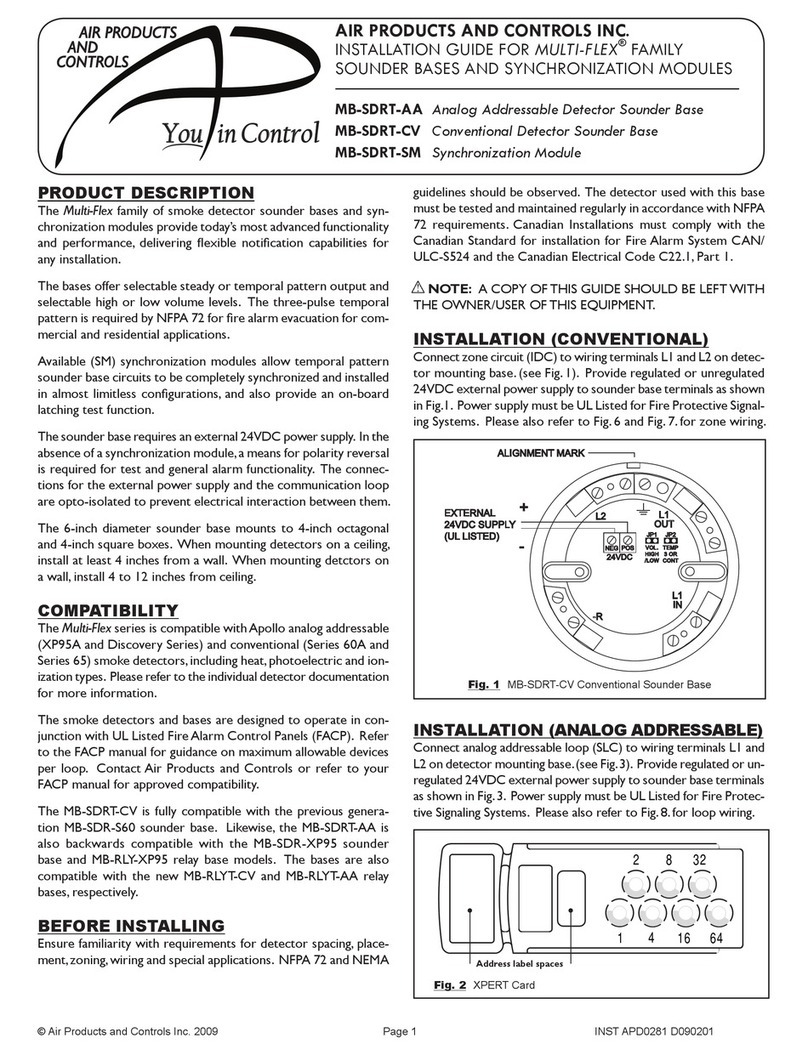
Air Products & Controls
Air Products & Controls Multi-Flex Series installation guide
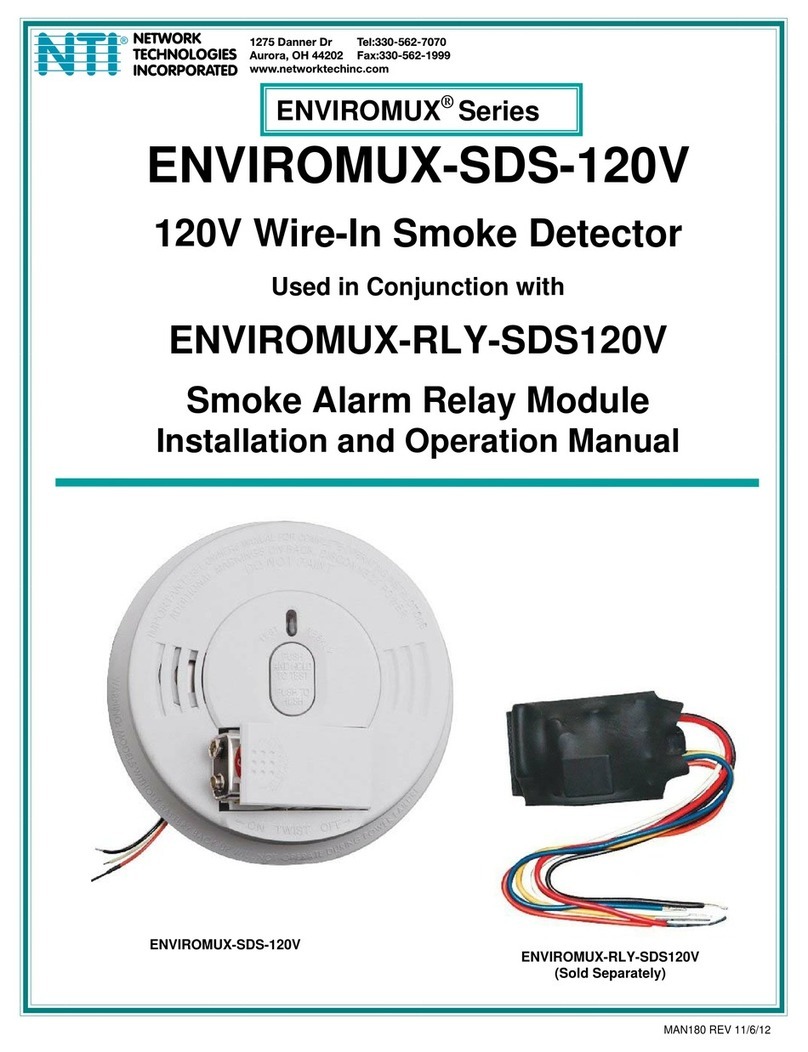
Network Technologies
Network Technologies ENVIROMUX-SDS-120V Installation and operation manual
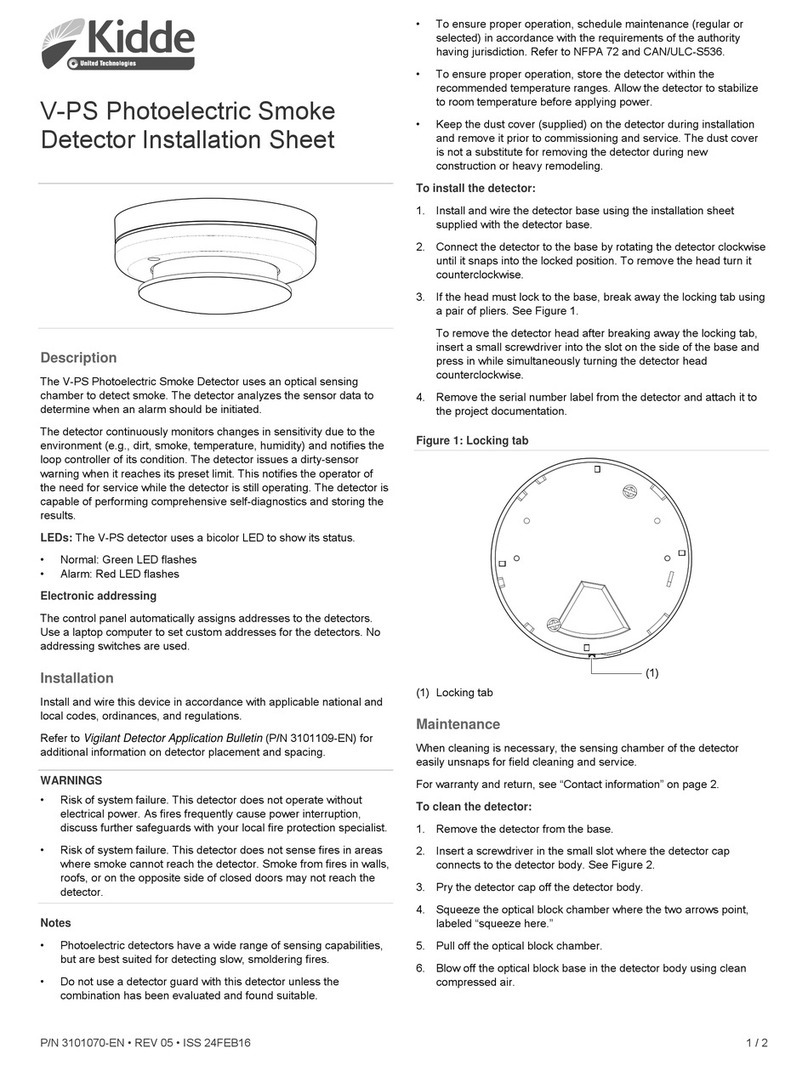
Kidde
Kidde V-PS Installation sheet
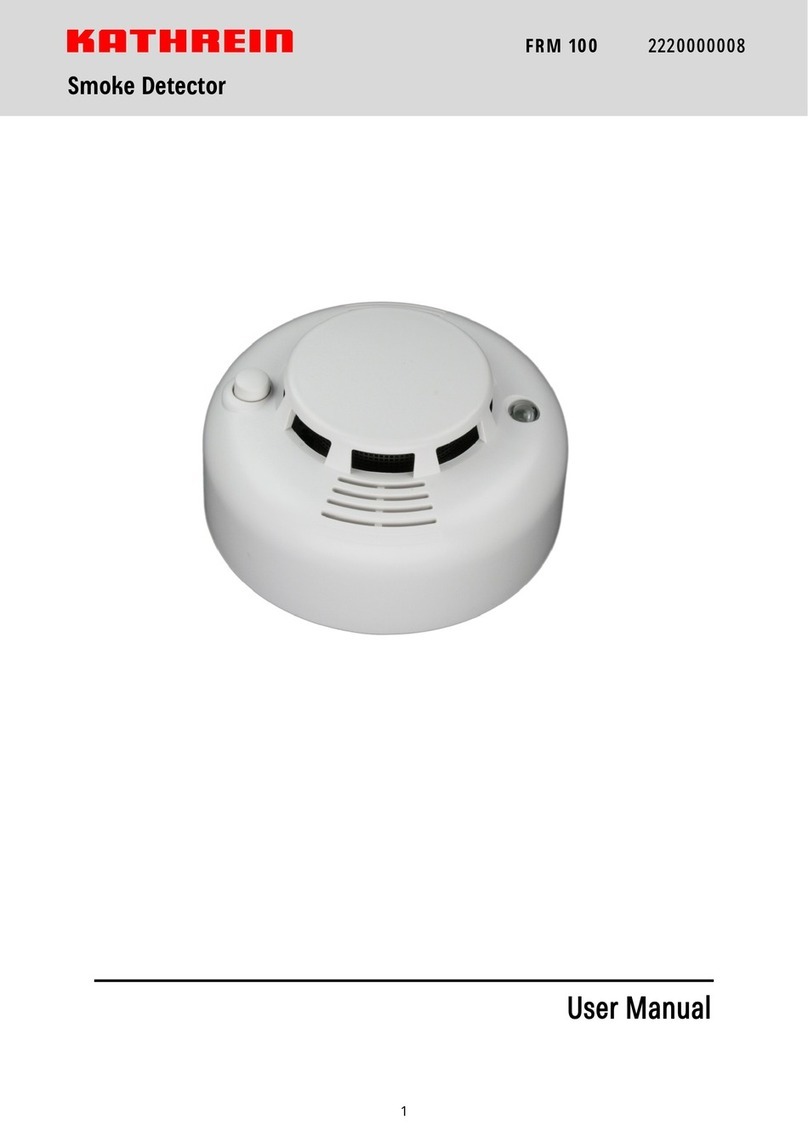
Kathrein
Kathrein FRM 100 user manual
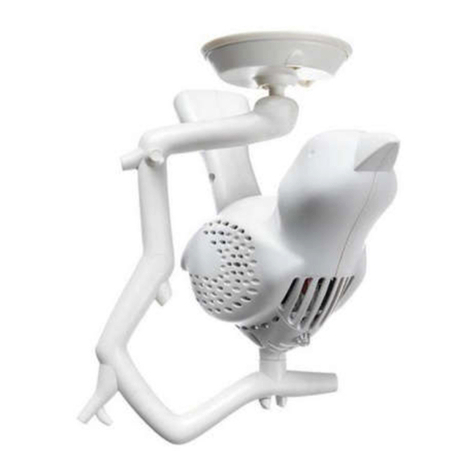
The Initiator and Company
The Initiator and Company Chick-a-Dee user guide
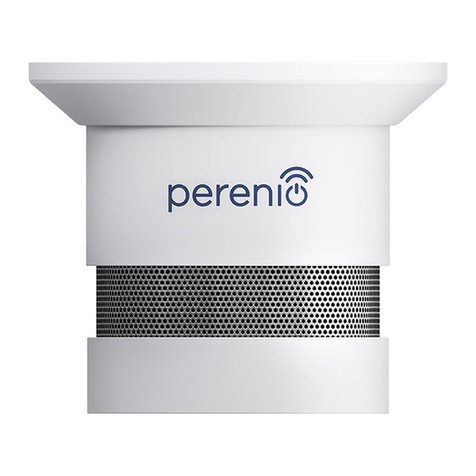
Perenio
Perenio PECSS01 quick start guide

AROHA
AROHA SM11W Quick reference guide

LST
LST WMSTR-WR-P01 Specification sheet
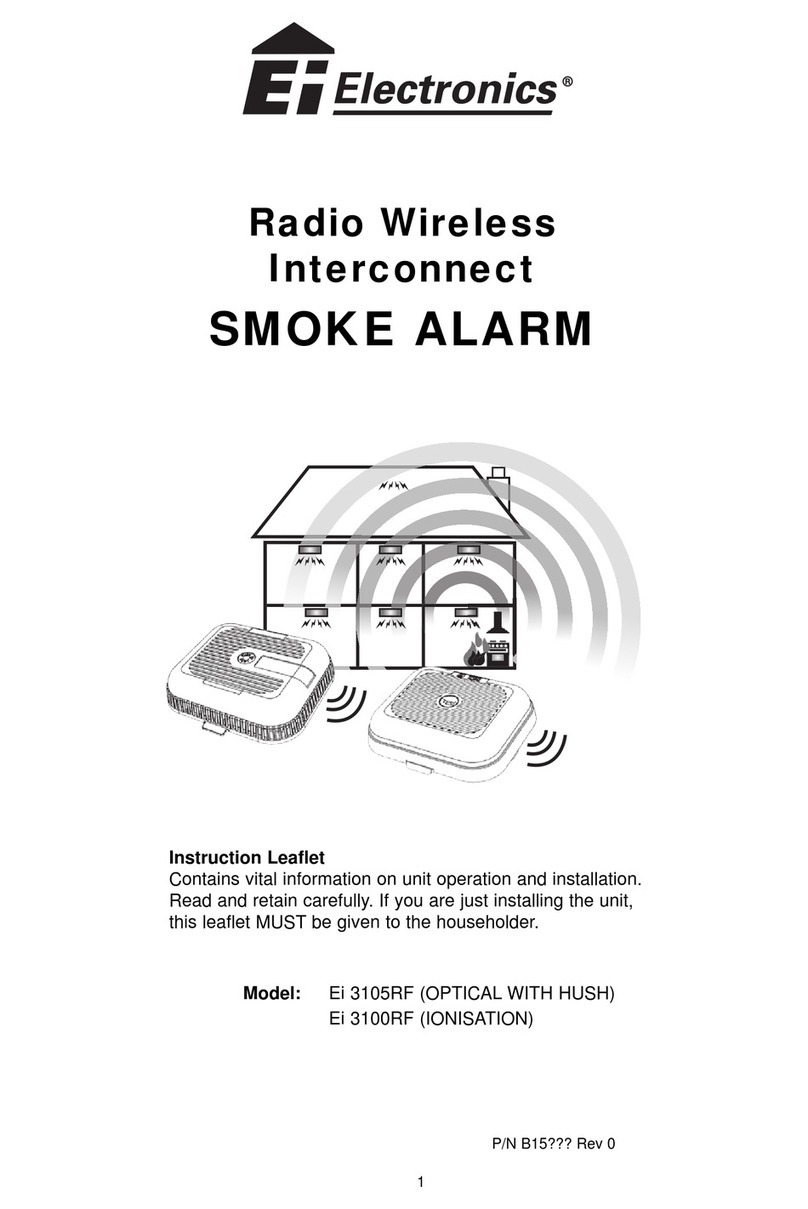
Ei Electronics
Ei Electronics Ei3100RF? Ei3500RF Instruction leaflet
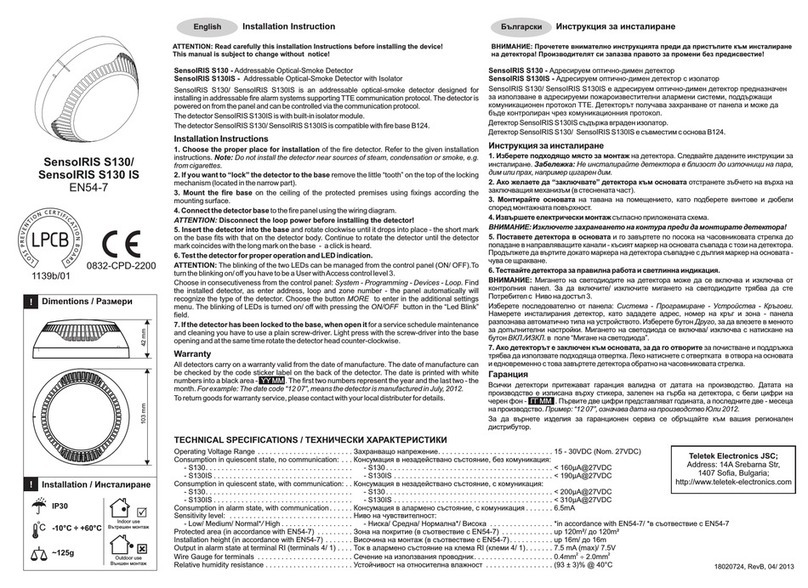
Teletek electronics
Teletek electronics SensoIRIS S130 Installation instruction
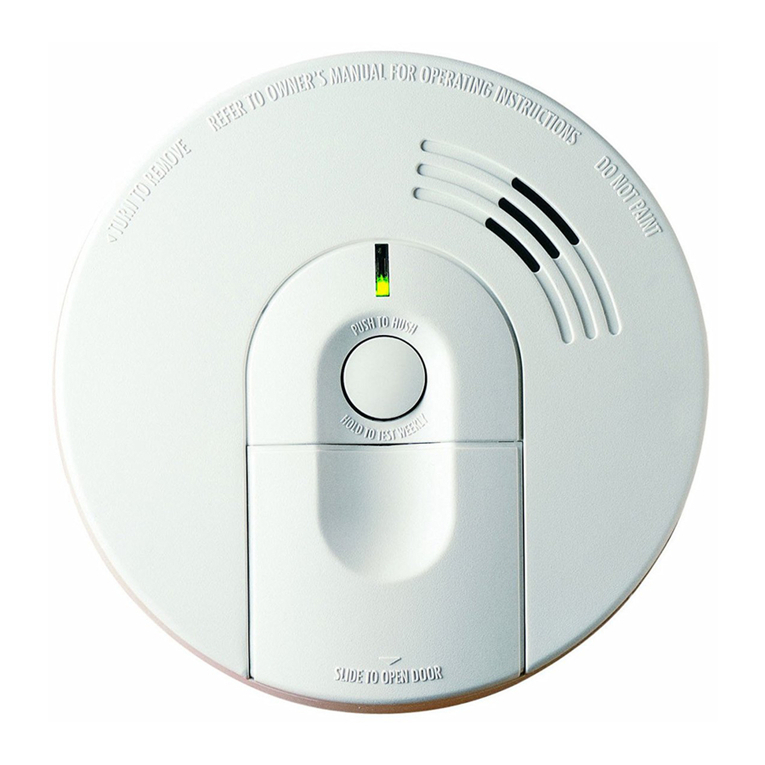
Firex
Firex FADC manual

Red Smoke Alarms
Red Smoke Alarms R240RC installation instructions
